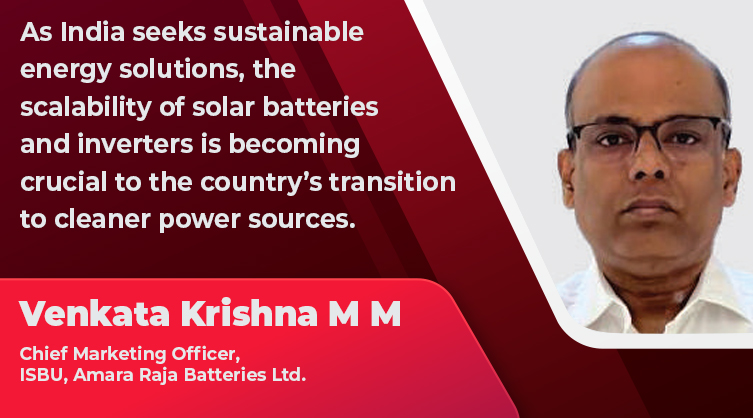Optimising solar Battery and inverter scalability
By EPR Magazine Editorial September 26, 2023 2:43 pm IST
By EPR Magazine Editorial September 26, 2023 2:43 pm IST

As India seeks sustainable energy solutions, the scalability of solar batteries and inverters is becoming crucial to the country’s transition to cleaner power sources.
How do solar batteries address India’s energy intermittency, and what factors guide battery chemistry selection?
Solar batteries are a clean and renewable energy source that can help reduce carbon emissions and mitigate climate change problems. While solar power is limited to producing energy only in the daytime, solar batteries can help solve the energy intermittency problem as the battery banks are used during power outages to store electricity. These batteries are generally deep cycle batteries as the current flows from the battery in small quantities and evenly. Several factors guide the selection of battery chemistry for solar applications in India:
Lead-Acid Batteries: Lead-acid batteries, including flooded, gel, and AGM (Absorbent Glass Mat) variants, are commonly used due to their affordability and availability. They are suitable for applications where cost is a primary concern. Flooded lead-acid batteries require regular maintenance but are the least expensive option. Gel and AGM batteries are maintenance-free and offer better performance.
Advanced AGM VRLA Batteries: Advanced AGM VRLA (Valve-Regulated Lead-Acid) batteries are specifically designed for deep cycling applications in solar systems. They offer higher round-trip efficiency compared to traditional lead-acid batteries.
Lithium-Ion Batteries: Lithium-ion batteries are gaining popularity for solar lanterns and street lighting due to their compact form and longer cycle life. However, lead-acid batteries are still preferred for residential and commercial applications, requiring longer backup times and cost-effectiveness over the long term.
The choice of battery chemistry depends on factors such as cost, maintenance requirements, cycle life, capacity, and the specific needs of the solar installation.
What role do solar inverters play in grid integration and efficient power conversion?
Solar inverters are essentially the brain of the solar system as they control the flow of electricity from the panels to the grid or batteries. Solar inverters integrated with intelligent Energy Management Systems (EMS) can help establish proper grid integration, which is becoming a big challenge as the need for renewables is increasing. Grid services play a crucial role in integrating solar energy into the electrical grid and ensuring that the electricity supply meets demand and maintains a stable voltage level within the grid. In addition, they also provide frequency regulation and reactive power control services that can ensure that solar energy maintains stability throughout the entire electrical system.
The choice of inverters is guided by their efficiency and the ability to get integrated with the grid and orchestrating batteries whenever backup power is required in the absence of solar generation. It also depends on grid requirements, solar installation size, budget constraints, and the need for advanced features to optimise energy generation and consumption.
How can solar battery and inverter scalability be optimised across India’s residential, commercial, and utility projects?In the residential space, home inverters adoption has grown significantly in the last decade to offset the power outage. In this, a few pockets are slowly adopting the solarisation of home inverters.
Homeowners can start with small-scale solar installations and gradually expand their systems by adding more solar panels, batteries, and inverters. Investing in modular and expandable systems allows for easier scalability over time.
The government of India’s mandates for reducing Diesel Generators of more than five years also complement the scalability of energy storage systems. Battery storage systems with fast charging for intermittent intervals are a way to optimise the design formats of both inverter and batteries.
Meanwhile, diesel generators are now used as an emergency backup supply in commercial projects in most commercial buildings. With an inspired commitment to embracing renewables to reduce the time-of-day tariff regime, most businesses are being directed to consider the possibility of Battery Energy Storage systems. Furthermore, the Ministry of Power has mandated certain measures to adopt Renewables and Energy Storage Systems to scale up in a big way as an alternative to conventional energy. Businesses can assess their energy needs and design solar systems with scalability. Battery storage systems with fast charging capabilities can be implemented to handle intermittent energy demands. Considering peak load shaving can help optimise energy usage and reduce electricity costs.
How does regulation impact solar battery and inverter adoption, and what policies can promote their use while ensuring grid stability?
The Government of India has recognised the energy and power sector as one of the crucial and critical components of growth for the Indian Economy. It believes India’s energy and power sector has a vast untapped potential for International investment. Schemes floated by the government, like DDUGJY (Deen Dayal Upadhyay Gram Jyoti Yojana) and IPDS (Integrated Power Development Scheme), coupled with approval of 100% FDI in the electrical machine industry, have accounted for this huge growth in demand for electricity.
For the last couple of years, MoP guidelines and various mandates towards green initiatives have driven the quick adoption of Renewables, which has eventually led to an increase in the adoption of energy storage systems. However, elaborate programme initiatives must be driven with a collaborative approach by State and Central governments to bring awareness and consciousness for consumers to choose non-fossil fuels and energy storage systems.
To promote solar batteries and inverters while ensuring grid stability, governments should create a supportive regulatory environment that balances the interests of renewable energy users, utilities, and the overall grid infrastructure. This includes incentives, standards, and programs encouraging responsible adoption and grid-friendly practices.
We use cookies to personalize your experience. By continuing to visit this website you agree to our Terms & Conditions, Privacy Policy and Cookie Policy.